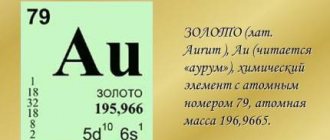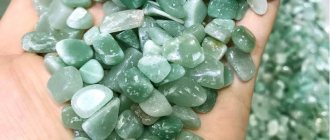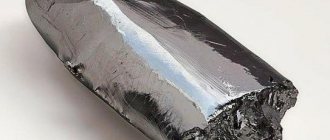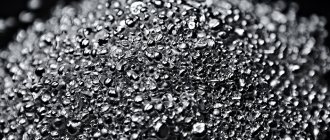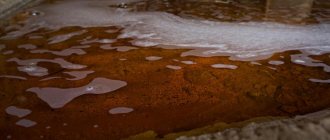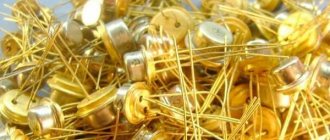Certain properties of gold have made it one of the most valuable metals on Earth. Pure gold is an element and a mineral. People value it for its attractive appearance, ability to maintain bright color for a long time and a number of other unique properties. Gold has been called the most beautiful of all chemical elements. This is the first metal that people began to use in its pure form. It has been used in jewelry, coin making, and art for thousands of years.
Gold is a noble metal
Distribution in the surrounding world
Gold can be found mainly in the form of nuggets. Trace amounts are found everywhere, but large deposits are found only in a few places. It can be found either in pure gold deposits or in combination with other related metals. Ore or vein gold is located in primary deposits, and wash or placer gold is located in secondary deposits. Vein deposits, depending on how deep they are from the surface of the earth, are divided into high-temperature and low-temperature. The presence of silver or copper in the rock gives it a different shade: from golden yellow to silvery white. The admixture of copper gives it a pinkish tone with a metallic sheen.
The world's oceans contain gold in the amount of 5–10 mg per 1 ton of water, so it is unprofitable to extract it from sea water industrially. Gold is found both in the form of nuggets and as part of ores. In addition, it is found in the form of compounds with hydrogen sulfide, which occur in geothermal waters. Metal is obtained in several ways:
- leaching from gold-bearing rock;
- amalgam method;
- cyanide method.
The level of purity of gold and the presence of excess impurities in it is indicated by a sample. It is written in ppm (%o) and shows the percentage of pure gold. So, 560 sample means that the sample contains 560% and 440% foreign impurities.
Getting gold
Gold can be extracted from placer deposits by flotation (precipitation), based on the large difference in densities of gold and waste rock. Gold is almost 20 times heavier than water and about 8 times heavier than sand,
Therefore, grains of gold can be separated from sand or crushed waste rock with a stream of water. The ancient method of washing using sheep skins, on which gold grains were deposited, is reflected in the ancient Greek myth of the Golden Fleece. Nuggets and placers of gold were often found along rivers, which eroded gold-bearing rocks for thousands of years. In ancient times, gold was mined only from placers. And now, where they remain, gold-bearing sand is scooped up from the bottom of rivers and lakes and enriched in dredges - huge structures the size of a multi-story building, capable of processing millions of tons of gold-bearing rock per year.
However, this method, which was already used in ancient times, is associated with great losses. It gave way to amalgamation (known already in the 1st century BC and used in America from the 16th century) and cyanidation, which became widespread in America, Africa and Australia in the 1890s.
The old (so-called mercury) method of extracting gold from ore - amalgamation is based on the fact that mercury wets gold well - like water wets glass. Finely ground gold-bearing rock was shaken in barrels with mercury at the bottom. At the same time, gold particles stuck to the liquid metal, being wetted by mercury from all sides. Because the color of the gold particles disappears, the gold may appear to have “dissolved.” The mercury was then separated from the gangue rock and heated to high temperatures. The volatile mercury was distilled off, but the gold remained unchanged. The disadvantages of this method are the high toxicity of mercury and the incomplete extraction of gold: the smallest particles are poorly wetted by mercury.
At the end of the 19th and beginning of the 20th centuries, indigenous deposits became the main source of gold. Gold-bearing rock is crushed and leached with sodium cyanide, in which even the smallest grains are converted into water-soluble cyanide compounds. Then gold is extracted from an aqueous solution using zinc powder: 2Na[Au(CN)2] + Zn → Na[Zn(CN)4] + 2Au. Leaching makes it possible to extract the remaining gold from the dumps of abandoned mines, essentially turning them into a new deposit. The method of underground leaching is also promising: a cyanide solution is pumped into wells, it penetrates through cracks into the rock, where it dissolves gold, after which the solution is pumped out through other wells.
Another method of purifying gold by electrolysis was proposed by E. Wohlwill in 1896. Anodes cast from impure gold are suspended in a bath containing a hydrochloric acid solution of AuCl3; a sheet of pure gold serves as the cathode. In this case, when a current passes, impurities precipitate (anodic sludge, sludge), and gold with a purity of at least 99.99% is deposited on the cathode.
Physical characteristics of the metal
Gold is a shiny yellow metal. During the heating process, it oxidizes and a reddish tint (red) appears. The main physical properties of gold are as follows:
- melting point – 1063ºС;
- density – 19.32 g/cm3;
- hardness (Mohs scale) - 2.5–3;
- boiling point – 2700ºС.
Gold is a very ductile metal
The metal has fairly good reflective properties, is ductile and is easy to polish. 1 g of Au can be rolled into a sheet no more than 0.0001 mm thick or stretched into a long wire (up to 3.5 m). Gold, due to its softness, is almost never used in its pure form. Alloys with other metals lower the melting point, changing the mechanical characteristics of Au. This property has long been used in production: for applying gilding, making dentures and various products.
How to distinguish a fake?
There are several ways to distinguish a genuine product from a counterfeit. It should be noted that using only one test does not guarantee the accuracy of the result. It is better to check on several parameters. So, experienced jewelers use the following methods to distinguish gold from fake:
- Check softness. Real yellow metal is very soft. If you bite into it, it will leave a mark. This is exactly how you can spot a fake. Alloys with a minimum content of noble metal are hard.
- Check the sound. Real gold jewelry rings softly and easily. But you shouldn't rely on hearing alone. Different impurities distort the sound in different ways.
- They drip with iodine. If the product contains a large proportion of the desired metal, then a drop of iodine placed on the surface of the object will turn black. Otherwise, it will turn white.
- They draw on the tiles. Since the density of gold is higher than tile, it should leave a characteristic golden mark on it. If it is a fake, then the mark will remain on the product. Also, traces of gold dust will remain on the skin if the product is thoroughly rubbed, for example, on your hand.
- Weigh on special scales. If the metal density is less than declared, then the weight of the product will be less.
- Scrape the back of the object. This is done in order to find out whether ordinary copper or tungsten is hidden under a layer of gold.
Potential buyers should be wary of the following points:
- lack of documentation;
- discrepancy between the mark and the hallmark declared in the documents;
- corrections in documents;
- erased hallmark;
- hallmark of the Soviet period;
- unusual color of the product.
If something incomprehensible confuses you and there are any suspicions, this is a sure sign that you should first show the product to a professional, an appraiser or a pawnshop employee, and only then make a decision to purchase.
Types of alloys
In gold alloys, additional components can be: silver, copper, nickel, palladium, platinum, zinc, cadmium. Each of the substances has its own effect on gold and the properties of the alloy:
- Silver slightly lowers the melting point, while changing the color of Au, but maintains the strength at the same level. High Ag content results in a color change from yellow to lighter.
- Copper slightly increases the hardness of the joint, while maintaining ductility and malleability. When the Cu content reaches 14.6%, the alloy acquires a bright red tone. The main disadvantage of such alloying is a decrease in anti-corrosion properties. The alloy may darken if there is too much copper.
- Nickel also changes the hardness of the joints, increasing it, and gives the joint a white color with a subtle yellow tint.
- Palladium changes (increases) the melting point of Au and gives the alloy a white color with a steely tint. Such gold is qualitatively superior to other compounds and is considered more noble.
- Platinum gives gold a perfect white color, removing yellowness.
Gold is one of the rarest metals in nature
Gold is considered one of the heaviest metals. Therefore, gilding is often used for volumetric products - coating with a thin layer of precious metal. It is carried out by rolling foil or by electroplating using an electrolyte, as well as by an autocatalytic reaction. Such coatings are distinguished by high durability and reflective properties. Gold-plated parts are used in radio equipment and X-ray machines.
Gold for medicinal purposes
The first methods of treatment with yellow metal, as well as its basic physical and chemical properties, were reflected in the works of ancient scientists and alchemists. Gold was studied during the Middle Ages, and scientific research in this area continues today. Scientists from different countries are striving to find new ways to use the precious metal in medicine and industry.
Even in ancient times, gold was considered a remedy for many diseases, a real elixir of life. Our ancestors believed that if gold has power over a person, then it can cure his ailments: remove pain, give strength and vigor, relieve stress, eliminate emerging symptoms of diseases.
The healing properties of gold include:
- Relieving inflammation;
- Improving metabolic processes in the body;
- Allergy cure;
- Beneficial effects on the nervous system;
- Stimulates brain activity and improves memory;
- Increasing the endurance of the human body.
When treating with gold, you do not need to do any special procedures; it is enough to wear jewelry made from this precious metal. Ancient healers believed that gold prolongs life.
The main medicinal properties of gold are usually used in alternative medicine. Gold jewelry is recommended for anyone who has heart problems, liver problems, skin diseases, or women's problems. The precious metal is capable of killing viruses and harmful microbes, so it can serve as an additional means of prevention during the flu season.
The beneficial properties of the solar metal allow folk healers to recommend wearing gold for:
- Energy replenishment of the body;
- Gaining self-confidence;
- Protection from the evil eye and damage;
- Maintaining a good mood and quickly recuperating;
- Successful fight against depression and stress;
- Productive brain and memory function.
The use of gold for medicinal purposes may not be suitable for everyone: some people have an individual reaction to the metal.
Those who like to wear a lot of massive jewelry made of yellow metal need to evaluate whether they are harmful to the body. The properties of gold, aimed at helping a person, may not be useful at all in some cases. If you have sensitivity to metal, hair growth may worsen, depression may appear or simply a bad mood may prevail, tooth decay may begin, malfunctions in the functioning of internal organs or simply an allergy to the skin may occur. In such situations, the use of gold jewelry must be strictly limited.
Chemical properties
Au, like all noble metals, is a passive chemical element. The substance does not oxidize in air and is inert to most both inorganic and organic substances. Gold is not affected by concentrated acids and alkalis. The exceptions are heated selenic acid and “regia vodka” (a combination of concentrated hydrochloric and nitric acids), dissolving in which Au forms acid, chlorauric acid. The valency of the metal can vary depending on the type of compound and is +1 or +3. Au is easily recovered from compounds. When heated, it enters into a chemical reaction with halogens, and at normal temperatures it forms bonds with chlorine and bromine water. Gold does not interact with other non-metals.
Gold reacts with chlorine and hydrochloric acid
When thin sheets or powder of this metal are exposed to chlorine at 200ºC, gold chloride is formed with an oxidation state of +3. When dissolved in water, the red needles of this compound form a complex compound with acidic properties, coloring the solution red-brown. By treating gold chloride with a caustic alkali, you can obtain a yellow-brown metal hydroxide, which has the properties of an acid and is therefore called golden acid, its salts are aurates. The latter are unstable and decompose when the temperature rises; with a number of organic substances they form explosive mixtures.
The chemical properties of the element make it possible to determine the authenticity of gold at home. A drop of hydroalcoholic iodine leaves dark, difficult-to-remove stains on the metal of 585 and 583 samples. High grade gold does not react with iodine.
Counterfeiting gold jewelry
If something sells well, it's a sign that something can be faked to match it. Counterfeiting of gold is perhaps one of the most common fraudulent schemes today, which is ensured by the high cost of the precious metal. Most often, “white gold” is counterfeited, passing off ordinary high-grade silver as an alloy with platinum. But an experienced buyer will always distinguish one precious metal from another.
Another chemical element that is ideal for counterfeiting gold is tungsten. Light bulb hairs, electrodes, and so on are made from it. This chemical element has a density similar to gold, so its weight is practically indistinguishable from the noble metal.
In addition, sometimes the hallmark is faked. If there are doubts about the quality of the product or if the hallmark mark does not match the hallmark number indicated in the accompanying documents, it is better to refuse to purchase such a product.
A little about the magic of gold
Gold is considered a solar metal, a very powerful and strong element. The magical properties of gold, as the metal of the Sun, affect strong people whose cosmograms have clearly expressed male signs. According to the zodiac signs, the precious metal is recommended for constant wearing for Leo, Taurus and Aries; depending on how you feel, you can wear gold jewelry for Sagittarius, Aquarius, Scorpio, Gemini; for other signs, wearing gold should be occasional.
Gold brings wealth. The magical characteristics of the metal testify to its attraction of new money, to the endowment of a person with the courage and courage that are necessary to achieve all the goals set for oneself.
A gold medallion in the shape of the sun has long been considered a talisman for those who work underground. It allows you to maintain good spirits, restore physical strength, and also protects you from collapses and other misfortunes. A medallion made of precious metal, worn in the solar plexus area, performs a protective function against any love spell.
For those who want to experience gold and its magical properties as a metal, it is necessary not only to wear precious jewelry, but also to believe in its effect. By gaining self-confidence, you will be able to realize all your goals and dreams that until recently seemed unattainable.
The very different properties of gold - physical, chemical, medicinal - determine its value in human society and the demand for the metal in the modern world. The precious metal market has been experiencing a shortage for many years: supply is much lower than demand. Gold, technical analysis of which shows a decline in sales, is constantly rising in price, but metal production continues to decline from year to year. Compensation for the shortage of metal, which, due to its characteristics, is in demand not only in the field of investment and jewelry, but is also widely used in industrial production, occurs only through smelting and reusing the yellow metal.
Gold does not interact with acids and alkalis
Gold is not able to dissolve in an acid-base environment. It can be dissolved only in one case - when combined with aqua regia, which is a concentrate of two acids:
- of hydrochloric acid
- nitric acid
If you look at the works of alchemists of different generations, you can see that they illustrated the research of this reaction in the form of a drawing of a lion that devoured a disk with the sun's rays.
Aqua regia
There are many acids that can corrode living tissue and leave terrible chemical burns (even death). However, there is no single acid in which gold dissolves. Of all the acids, only the famous mixture - aqua regia - can affect it. These are nitric and hydrochloric (hydrochloric) acids, taken in a ratio of 3 to 1 by volume. The remarkable properties of this hellish cocktail are due to the fact that acids are taken in very high concentrations, which greatly increases their oxidizing ability.
Aqua regia begins to act when nitric acid begins to oxidize hydrochloric acid first, and during this reaction, atomic chlorine is formed - a very reactive particle. It is she who attacks gold and forms a complex with it - chlorauric acid.
This is a very useful reagent. Very often, gold is stored in the laboratory in the form of crystalline hydrate of such an acid. For us, it only serves as confirmation that gold dissolves in aqua regia.
It is worth paying attention once again to the fact that it is not one of the two acids that oxidizes the metal in this reaction, but the product of their mutual reaction. So if you take, for example, “nitrogen” alone - a well-known oxidizing acid - nothing will come of it. Neither concentration nor temperature can make gold dissolve in nitric acid.
How to check the authenticity of gold
The chemical properties of gold do not allow it to react with liquid bromine or cyanide solution. This rule also works under conditions of natural access to oxygen. However, there is an exception here. The metal can be dissolved in the following concentrates:
- pure iodine;
- potassium iodide;
- iodine water;
- bromine water.
As the ambient temperature increases, the ability of gold to react to the presence of other compounds increases several times (we are talking about selenic acid). The only condition: selenic acid must be in the form of a concentrate and have the appropriate temperature. Today, this chemical property is used to verify the authenticity of gold or to clean it of excess impurities.
Bonus
When we said that single acids are something in which gold does not dissolve, we lied a little - in fact, such acids exist.
Perchloric acid is one of the strongest acids. Its oxidizing properties are extremely high. In a dilute solution they show up poorly, but in high concentrations they work wonders. The reaction produces its salt, gold perchlorate, which is yellow and unstable.
Of the acids in which gold dissolves, there is also hot concentrated selenic acid. As a result, a salt is also formed - gold selenate of red-yellow color.
Being in nature
Gold in a free state or alloyed with other metals is not widespread in the earth's crust, but point sources of extraction are very numerous. These are mainly post-magmatic zones or hydrothermal; gold is also mined in places where primary deposits are destroyed and along its bed.
The main sources of extraction of precious metal from its ores, which include gold, platinum, silver, etc. , is that under the influence of water, air and other factors, natural alloys and compounds are sold out and immigrate from the main zone (bedrock deposit, hydrothermal and post-magmatic) to places where they form placers (primary gold deposits) or sedimentary rock, which over time can also turn into a solid state (example pyrite). Native gold: natural alloys of gold with iridium, platinum gold, rhodium-gold, silver-gold (electrum), palladium-gold (porpesite), copper-gold (cuprous gold).
Natural gold minerals: these are mainly minerals that include Te tellurium, AuTe2 (calaverite), Ag3AuTe2 (petzite), (AgAu)Te (mutmanite), Au2Te3 (montbreuite), Pb5AuSbTe3S6 (nagiagite) and others.
Organic and inorganic gold compounds and humans
Gold in the form of salts and some organic compounds behaves as a toxic substance that accumulates in vital organs and causes some diseases associated with the blood and immune system.
Organic gold-based medicines are used to treat autoimmune diseases and some other types also related to the immune system. Manufacturing of cosmetics containing gold.
Historical background on the use of gold
Gold was the first metal known to man. Gold items were found in the cultural layers of the Neolithic era (5th-4th millennium BC). In ancient states - Egypt, Mesopotamia, India, China, the mining of gold, the manufacture of jewelry and other items from it existed 3-2 thousand BC. e. Gold is often mentioned in the Bible, the Iliad, the Odyssey and other monuments of ancient literature. Alchemists called gold the “king of metals” and designated it with the symbol of the Sun; the discovery of ways to transform base metals into gold was the main goal of alchemy.
Initially, gold was used exclusively for making jewelry, then it began to serve as a means of saving and accumulating wealth, as well as exchange (first in the form of ingots). Gold was used as money as early as 1500 BC. e. in China, India, Egypt and the states of Mesopotamia, and in Ancient Greece - in the 8th-7th centuries. BC e. In Lydia, rich in gold deposits, in the 7th century. BC e. The minting of the first coins in history began. The name of the Lydian king Croesus (reigned around 560-546 BC) became synonymous with untold wealth. On the territory of the USSR (in Armenia), gold coins were minted in the 1st century. BC e. But in ancient times and in the Middle Ages, gold was not the main currency metal. Along with it, the functions of money were performed by copper and silver.
The pursuit of gold and the passion for enrichment were the reasons for numerous colonial and trade wars; during the era of the Great Geographical Discoveries, they pushed people to search for new lands. The flow of precious metals to Europe after the discovery of America was one of the sources of the initial accumulation of capital. Until the middle of the 16th century. From the New World, mainly gold was imported to Europe (97-100% of the imported metal), and from the 2nd third of the 16th century, after the discovery of the richest deposits of silver in Mexico and Peru - mainly silver (85-99%).
In Russia at the beginning of the 19th century. New gold deposits began to be developed in the Urals and Siberia, and for three decades the country ranked first in the world in its production. In the middle of the 19th century. Rich gold deposits were discovered in the USA (California) and Australia in the 1880s. - in the Transvaal (South Africa). The development of capitalism and the expansion of intercontinental trade increased the demand for monetary metals, and although gold production increased, in all countries, along with gold, silver continued to be widely used as money. At the end of the 19th century. There was a sharp decrease in the cost of silver due to the improvement of methods for its extraction from polymetallic ores. The growth of world gold production and especially the influx of it into Europe and the United States from Australia and Africa accelerated the displacement of depreciated silver and created the conditions for the transition of most countries to monometallism (gold) in its classical form of the gold coin standard (see Gold standard). The first to switch to gold monometallism was at the end of the 18th century. Great Britain. By the beginning of the 20th century. gold currency has established itself in most countries of the world.
- The first gold miners. Ancient mines in southern Egypt date from 5500 to 3100 BC. e. Recognizing the antiquity of the mines, some scientists are inclined to believe that the Mesopotamians took up gold mining before the Egyptians, and the subjects of the pharaohs borrowed the proven technology. This is confirmed by the fact that the mines found are located in an area that was one of the stages of the ancient trade route between Egypt and Mesopotamia.
